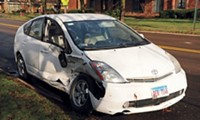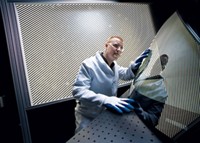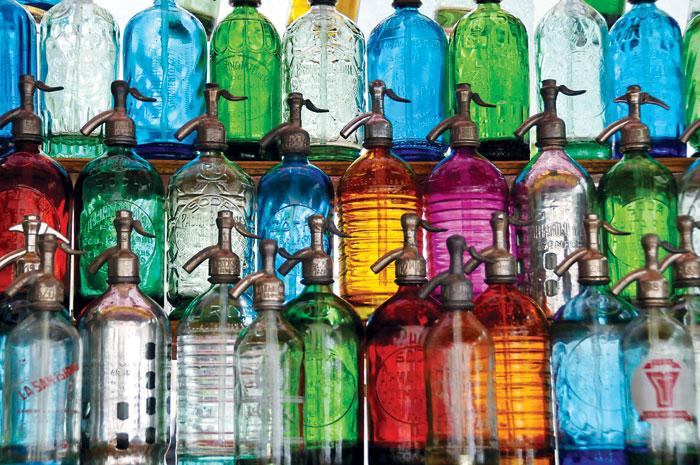Advertisement
Grab your lab coat. Let's get started
Welcome!
Welcome!
Create an account below to get 6 C&EN articles per month, receive newsletters and more - all free.
It seems this is your first time logging in online. Please enter the following information to continue.
As an ACS member you automatically get access to this site. All we need is few more details to create your reading experience.
Not you? Sign in with a different account.
Not you? Sign in with a different account.
ERROR 1
ERROR 1
ERROR 2
ERROR 2
ERROR 2
ERROR 2
ERROR 2
Password and Confirm password must match.
If you have an ACS member number, please enter it here so we can link this account to your membership. (optional)
ERROR 2
ACS values your privacy. By submitting your information, you are gaining access to C&EN and subscribing to our weekly newsletter. We use the information you provide to make your reading experience better, and we will never sell your data to third party members.
Environment
Donald Stookey—The Guy Who Gave Us CorningWare— Dies At 99
His ceramics inventions at Corning helped guide missiles, make unbreakable cookware, and kept people from squinting
by Stephen K. Ritter
December 5, 2014

Stanley Donald Stookey, a chemist who was as durable as the glassware and ceramics he invented during a 47-year career at Corning Glass Works, died on Nov. 4 near Rochester, N.Y. He was 99.

Stookey is best remembered for an accidental discovery in the 1950s of a remarkably strong ceramic material that could be used to make the nose cone of a guided missile and cookware to corral a casserole. Space-age gadgets and the company’s iconic CorningWare were just a few of Stookey’s inventions. His artisanal hand can be seen in technical glass ceramic materials used in telescopes and laboratory instrumentation as well as in eyeglasses and the screens of televisions and handheld electronics.
“What’s most notable about Don’s work and career is that he was an exploratory chemist––a real scientist’s scientist––truly inventing new things even while being in an industrial environment,” says David L. Morse, Corning’s chief technology officer.
FROM THE C&EN ARCHIVES
Read a 1961 C&EN Special Report on glass ceramics written by Stookey, as well as other past C&EN stories about Stookey’s work.
Controlled Nucleation and Crystallization Lead to Versatile New Glass Ceramics, by S. Donald Stookey
http://pubs.acs.org/doi/pdf/10.1021/cen-v039n025.p116
1951: New Photosensitive Glass Leads To Improved Chemical Engraving
http://pubs.acs.org/doi/pdf/10.1021/cen-v029n039.p3951
Stookey was born on May 23, 1915, in Hay Springs, Neb. His parents, both teachers, moved the family to Cedar Rapids, Iowa, when he was a boy. He later attended Coe College in Cedar Rapids, where his grandfather had been a professor of botany and geology. Stookey received a bachelor’s degree in chemistry and mathematics there in 1936, and then matriculated at Lafayette College in Easton, Pa., where he earned an M.S. in chemistry in 1938. Stookey received his doctorate in physical chemistry from Massachusetts Institute of Technology.
For Stookey, 1940 was an important year: He graduated from MIT, married his wife, Ruth (who died in 1994), and began working at Corning Glass Works.
According to a son, Bob, in a New York Times obituary, his father received two job offers after finishing at MIT. “One was from the Nabisco baking company”—known as National Biscuit Co. at the time—“and one was from a glass company he’d never heard of in upstate New York,” the younger Stookey said. “He knew he didn’t want to bake bread, so he went to Corning.”
At Corning, Stookey immersed himself in research, studying what he called the “exotic and mysterious” properties of glass chemistry, including the effect of metal oxides on glass crystallization. “My main objective was to be a pioneer, discover new things, produce things that had never been seen before,” Stookey once told the American Ceramic Society Bulletin. And so he did.
Amid a copper shortage during World War II, Stookey was part of a Corning effort to create pennies from photosensitive copper ruby glass disks, with Abraham Lincoln’s image appearing within the glass. The project was derailed because it cost 25 cents to make a glass penny; less expensive Zinc was used instead to make pennies during the war years.
But that work contributed to one of Stookey’s innovations in the late 1940s: a transparent aluminosilicate-based glass made photosensitive by the presence of trace amounts of gold, silver, or copper. Stookey found that three-dimensional designs could be etched into the glass, called FotoForm, and used for photography, printing, electronics, and designer windows.
Stookey’s biggest invention stemmed from a serendipitous event in 1952 when he took a piece of FotoForm and mistakenly heated it to 900 °C when he meant to heat it only to 600 °C. Stookey cursed when he realized he had botched the experiment—he thought he would open the oven to find a molten mess.
“When I came back, the temperature gauge was stuck on 900 degrees, and I thought I had ruined the furnace,” Stookey recounted in his autobiography, “Explorations in Glass,” published in 2000. “When I opened the door to the furnace, I saw the glass was intact and had turned a milky white. I grabbed some tongs to get it out as fast as I could, but the glass slipped out of the tongs and fell to the floor. The thing bounced and didn’t break. It sounded like steel hitting the floor.”
The material had crystallized so completely that it could not flow like amorphous glass does. It was harder than carbon steel yet lighter than aluminum––shatterproof. Stookey had discovered glass ceramics. Corning improved and patented the new material as Pyroceram, which joined Corning’s Pyrex borosilicate glass, already a staple of laboratory glassware and kitchenware, as one of the most important technological advances in materials science.
But Pyroceram was even more durable than Pyrex. Corning officials revealed this quality to the public in 1957 when they heated it with an acetylene torch and then plunged it into ice water during a demonstration. This maneuver would cause most glasses and ceramics to fracture, but Pyroceram suffered no ill effects. The New York Times noted at the time that, with Pyroceram, Stookey had managed to “crack the thermal barrier,” a decade after Air Force pilot Chuck Yeager had broken the sound barrier.
At first, the company looked at military applications for the new material, using it for nose cones in radar-guided missiles. But missiles were just the beginning. In 1958, the company introduced CorningWare, one of its most successful product lines, which is now owned by Illinois-based World Kitchen.
CorningWare was celebrated for being strong enough to withstand butterfingered mishaps in the kitchen, and it gave home cooks the ability to bake, serve, and refrigerate foods in the same dish. CorningWare was recognizable for many years by the blue cornflower pattern on its sides, and more than 50 years after its discovery, it’s still listed on wedding gift registries.
Another of Stookey’s inventions led to photochromic eyeglasses that darken and fade in response to varying light intensity, although these products have largely been replaced by plastic today. Beyond glass used in light bulbs and optical fibers, variations on his work led to nuts and bolts for the space shuttle, scratch-resistant glass stovetops, and Gorilla Glass used in cell phone, television, and other display screens.
“The passing of Don Stookey represents an end of a unique era of Corning’s innovative research,” says Nick Borrelli, a Corning scientist. “I had the pleasure to know and work with Don for many years and as yet have never met a more inventive scientist. In a way, I am still working with Don, since many of my present research projects link back to his pioneering efforts.”
In 1986, Stookey received the National Medal of Technology from President Ronald Reagan, who noted that Stookey’s developments at Corning helped the company generate $500 million in annual sales and more than 10,000 jobs. Among other honors, Stookey was a member of the National Academy of Engineering, received the American Chemical Society’s Award for Creative Invention in 1971, and was inducted into the National Inventors Hall of Fame in 2010. He was a 70-year, emeritus member of ACS.
Stookey’s financial rewards from his inventions allowed him to extend his exploratory spirit beyond the laboratory, Morse relates. “He loved to travel and to hunt and fish,” Morse says. “On one trip, he survived a plane crash in freezing water in Canada near the Arctic Circle. The next year he went right back to fishing. He was fearless; the unknown never daunted him.”
Stookey retired from Corning in 1987, but he continued to travel and explore, and often sent in postcards from far-flung destinations around the globe as well as new ideas for glass ceramics.
“Not only did Don challenge young scientists to stretch or redirect their conceptual thinking, but he always took a great interest in their families and recreational pastimes,” noted George Beall, a codeveloper of Pyroceram and a longtime Corning colleague and friend, in a foreword to Stookey’s autobiography. “Nothing was impossible in Don’s perceptive imagination; but, more importantly, he displayed just the right combination of technical skills, gritty persistence, and personal credibility to be able to assemble the resources for successful execution of his ideas.”
Stookey’s legacy at Corning lives on, Morse says. “We will continue to invent new glass ceramics that are stronger and more durable, there’s no doubt about that. The interaction of light and materials also remains a rich field that we are going to continue to explore.”





Join the conversation
Contact the reporter
Submit a Letter to the Editor for publication
Engage with us on Twitter